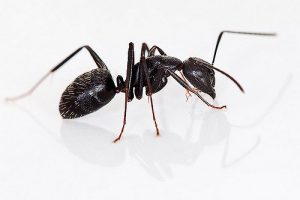 The Black Carpenter Ant is a native species and common species in the east. These ants get their common name from their habit of hollowing out galleries in pieces of wood for nesting purposes. The nesting habit can result in structural damage. Carpenter ants are found throughout the United States.
The Black Carpenter Ant is a native species and common species in the east. These ants get their common name from their habit of hollowing out galleries in pieces of wood for nesting purposes. The nesting habit can result in structural damage. Carpenter ants are found throughout the United States.
Workers are large, usually 1/8th to 1/2 inch, but vary greatly in size. Queens are about 1/2 to 5/8 an inch long. Their color can be black, combinations of red and black or just completely red or brown.
Although Carpenter Ants do not sting, their bites can be quite painful, especially when they inject formic acid into the wound.
The only external indication of an infestation other than the presence of workers and/or swarmers is the appearance of small openings or windows on the surface of the wood. Through these holes the workers can expel debris such as sawdust like shavings or fragments of insulation. The accumulation of such debris beneath such holes is a pretty good indication of an infestation.
Black Ant colonies are of moderate size and usually consist of about 3000 worker ants.
Most carpenter ant species establish their first nest in decayed wood and later expand or enlarge this into sound wood. Inside, nests are located in wood, insulation, or small wall voids. Outside, nests are typically located in rotting fence posts, stumps, old firewood, dead portions of standing trees and under stones or fallen logs.
Carpenter ants primarily feed on insect honeydew, plant and fruit juices, insects, and other arthropods. Inside they will also feed on sweets, eggs, meats, cakes, and grease.
Workers will forage for distances up to about 300 feet from the nest. They typically enter buildings around door and window frames, eaves, plumbing, utility lines, and shrub and tree branches that are in contact with the building.
The first step in combating an infestation is to determine if the ants are foraging in your home or if there is a nest in your home. Once the nest is located it should be treated with the appropriate pesticide. Barrier treatment is also effective for preventing entry.
